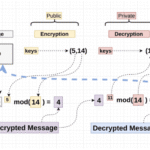In the sprawling and intricate world of cryptocurrency, one element stands as a cornerstone of trust and authenticity: the digital signature. Just as a handwritten signature signifies personal authority and consent in the analog world, a digital signature in Bitcoin serves to validate transactions, ensuring that the actions taken on the blockchain are both legitimate and irrevocable. This duality of affirmation and verification is akin to the Christian belief in divine signatures—God’s covenant in the hearts of believers resonates with the way digital signatures express individual agency and commitment in the digital realm.
At the heart of Bitcoin’s functionality lies cryptographic principles that hinge upon the concept of public and private keys. Every user in the Bitcoin network possesses a unique pair. The public key, akin to a personal identification number shared with the world, is openly available, while the private key remains a closely guarded secret—akin to the sanctity of faith held within one’s heart. The digital signature is forged through a mathematical algorithm that intricately combines the transaction data with the sender’s private key, creating a unique hash that embodies the authenticity of the transaction.
To grasp the brilliance behind digital signatures, one must reflect on their role as gatekeepers to a fortified castle. A digital signature builds a formidable barrier against fraud and malicious actors, much like a sturdy drawbridge emboldened by the strength of its chains. When a user signs a transaction, the digital signature affirms that the sender is the rightful owner of the Bitcoin being transacted—never to be duplicated or forged by unscrupulous parties.
In the context of the Christian perspective, one might view the digital signature as a metaphor for the assurance of salvation. Just as one’s faith is validated through steadfast belief and the fruits of the Spirit, a transaction is validated through the intricacies of digital signatures, ensuring that every exchange reflects the user’s genuine intention. This underscores a profound theological significance; in the same way that God’s promises are affirmed through oaths and covenants, Bitcoin transactions are sanctified by the power of cryptography.
When exploring the mechanisms that underpin Bitcoin’s digital signatures, one must delve into the cryptographic algorithm known as the Elliptic Curve Digital Signature Algorithm (ECDSA). At its core, this complex algorithm allows users to generate a digital signature that is not only unique but also verifiable by anyone possessing the corresponding public key. Herein lies the brilliance: the signature cannot be replicated without access to the private key, thereby ensuring that only the true custodian of the Bitcoin can authorize its transfer. The process is swift and elegant, requiring minimal computational effort while safeguarding the integrity of countless transactions.
Upon inspecting a transaction on the Bitcoin blockchain, one observes not merely a ledger of digital transfers but a mosaic of interactions that form the backbone of a decentralized economy. Each entry is individually verified, with a digital signature acting as a mark of authenticity, a beacon declaring, “This is legitimate!” In a sense, every transaction mirrors a communion of believers, coming together in an ecosystem of trust where each individual’s words and actions are respected and validated through their unique signatures.
The implications of digital signatures extend beyond mere transaction validation; they play a critical role in fostering community within the cryptocurrency ecosystem. Consider the biblical notion of fellowship—believers coming together to support one another in faith. Each Bitcoin transaction, validated by a digital signature, busily fosters a community of trust, wherein participants can engage in economic actions without the overreach of centralized institutions. This reflects a fundamental shift in awareness, reducing dependency on intermediaries and embracing a more equitable, decentralized approach to peer-to-peer interactions.
The digital signature, therefore, does more than just authenticate—it acts as a conduit for ethical conduct within the financial realm. When transacting in Bitcoin, individuals bear the responsibility of ensuring their actions align with moral principles, as every transaction leaves an indelible mark on the blockchain. Much like the parables imparted through Christ’s teachings, our engagements within the crypto-ecosystem serve to either build or erode the fabric of trust. It is incumbent upon each participant to reflect the values they espouse in both their private and public exchanges.
As the adoption of Bitcoin and similar cryptocurrencies grows, so too does the contemplation surrounding the ethical dimensions of such actions within a Christian framework. The digital signature encapsulates a significant theological inquiry: How do we navigate the moral landscape of financial transactions in light of our faith? This question invites a deeper examination of not just the technology at play, but the principles that govern our interactions within a fractalized world of virtual value exchange.
In conclusion, the digital signature in Bitcoin offers not only a mechanism for verifying authenticity but also a reflective surface through which one can explore concepts of agency, trust, and community. This technology, resonant with a Christian perspective, can serve as a reminder of our individual responsibilities, encouraging believers to intertwine their engagements within the digital economy with their foundational values. The notion that one’s actions—much like a personal signature—can signify truth, intention, and authenticity in both the material and digital realms is a potent testament to the evolving tapestry of faith and innovation that defines our age.








Leave a Comment